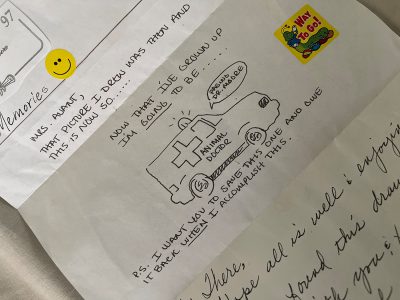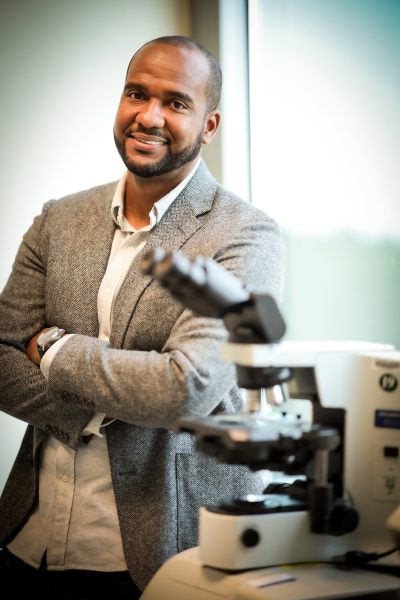Ian Moore, who directs the Comparative Medicine Branch’s Infectious Disease Pathogenesis Section at the National Institute of Health’s National Institute of Allergy and Infectious Diseases, has worked on many projects with critical implications for human health. But, he said, his most recent experience helping to develop the Moderna COVID-19 vaccine was unique.
During the early days of the pandemic, Moore recalls watching the news at home and seeing the reported COVID case counts in the US go up — first 14, then 20, then 600.
“Then in March, I got tapped to support the Moderna vaccine work because our lab was set up for this and my background as a flu researcher, so it was kind of an easy plug-and-play for me. But I knew it was going to be a big challenge,” Moore said. “You go outside and you see everyone in a mask, and you go to work and you go home and you know you’re working on that very thing that has everyone in a mask, keeping everyone from being near their loved ones, the thing that’s killing people across the country, across the world. That’s a lot to digest on a daily basis.”
Moore is a veterinary pathologist. On a normal day, he and his lab help infectious disease investigators set up and conduct research studies and generate and analyze data. Moore works on infectious diseases like zika, malaria, tuberculosis and influenza, as well as allergic diseases like eczema and food allergies. According to Moore, who was finishing up a critical study related to the pathogensis of human norovirus, all that work came to a halt when COVID arrived.
“That helped with the [vaccine] turnaround time. We put everything else on pause and just focused on the COVID vaccine,” said Moore.
Moore’s role in developing the vaccine was related to pre-clinical safety and efficacy studies. He focused on ensuring the vaccine was safe and effective in animal models before it went on to testing in Phase I, II and III human clinical trials.
“There are a lot of review processes in vaccine development but, luckily, when we were testing this vaccine in the pre-clinical phase, it worked so well and there wasn’t much doubt to be had. I just had to take my time and crawl through,” said Moore, who estimates he looked at more than 3,000 — and as many as 4,000 — sample slides from different animal species over the course of the pre-clinical studies. “At the end, I could sit back comfortable and confident because I knew I had gone through slides until my eyes were hurting. Then, I’d go back and do it again to make sure because before I send that report, I want to make sure I know exactly what I see — or don’t see.”
“You go outside and you see everyone in a mask, and you go to work and you go home and you know you’re working on that very thing that has everyone in a mask, keeping everyone from being near their loved ones, the thing that’s killing people across the country, across the world. That’s a lot to digest on a daily basis.”
Moore said that once the Moderna vaccine received emergency use approval from the U.S. Food and Drug Administration, he felt extremely grateful, a feeling that motivated him to reconnect with those who helped him get to that point in his career.
“I reached out to three of my high school and elementary school teachers to tell them, ‘Thank you,’ because I’d had some not-so supportive teachers in school who tried to actually discourage me from taking this path, and had I listened to them, this could be a very different situation. I would likely not be doing this right now,” said Moore.
In reaching back to his old teachers and small hometown in Alabama, Moore began sharing about the work he was doing on the Moderna vaccine. He got a lot of questions.

“My 9th grade teacher, specifically, we stayed connected, and she was asking me if she should get the vaccine or not, and I said ‘Absolutely.’ Now she’s had her second dose,” said Moore.
She also got involved in encouraging others to get vaccinated. Moore said his teacher became a community liaison. She spoke to their local newspaper, which ran a story about Moore’s involvement in the vaccine. “That’s what started me on this mass information drive because now the entire community knew what I was doing. It was like a frontpage story, and I was so not ready for that. But I accepted it because these are people who trust me because I’m from their town. They trusted my opinion and the information I was giving them, and that was invaluable.”
Moore says it was at that point he felt an obligation to continue sharing information about the COVID vaccine. “There were people calling me left and right about having COVID, worried they would get COVID, or about people I knew who had passed away from COVID. I felt an immediate need to do something about it, not just a vaccine, but to get accurate information to people.”
“Right now, [some] people just know that it’s new and someone wants to inject it in their arm and that’s all they know, and people say it’s safe. But I want to show them that it’s safe, and I can do that because I performed the preclinical safety and efficacy studies, which are the animal studies that are the first line of defense and show it’s safe, that it didn’t cause any damage or vaccine-associated disease in those tissues I evaluated, and that it’s effective, meaning it neutralized the virus that was in the tissues when these animals were challenged. Those two things are what allow the vaccine to go to larger clinical trials with humans.”
“It was like a front page story, and I was so not ready for that. But I accepted it because these are people who trust me because I’m from their town. They trusted my opinion and the information I was giving them, and that was invaluable.”
Moore has been doing this frequently, and even created his own handmade models to help teach.
“[During one Zoom] on an early Saturday morning, more than 150 people tuned in for a full two hours to learn about the vaccine,” said Moore. “It was only supposed to be 30 or 40 minutes, but people had questions and people were chatting the whole time. At the very end, there was a woman who unmuted herself and she said, ‘Before I started this call, I was not going to get vaccinated. I’m the primary caregiver and healthcare leader in my family. Because of this talk, I am absolutely getting this vaccine because I understand it now.’”
Moore reflects back on everything that’s happened during his COVID vaccine education efforts, all of which resulted from just one phone call, simply intended to show gratitude.
“It just felt full circle to me. [My teacher’s] kindness helped me, having someone who believed in what I was doing as a child, and then for her to be a recipient of a vaccine, 25 years later, that I helped create. I think it’s pretty cool,” said Moore.
MOVING ON TO OTHER BIOMEDICAL BATTLES
Moore's lab is still supporting Moderna's vaccine studies. But like all great scientists, his attention is in high demand. Regular, daily infectious disease work from pre-pandemic times has slowly begun to reemerge, like his norovirus work. Although Moore doubts — but is hopeful — that COVID's mark will fade from his work any time soon.
“mRNA technology is likely here to stay and will give people and animals an advantage over surviving future emerging diseases and pandemics,” he said. “I am excited to see what the future of research and, specifically, vaccinology, hold.”
Moore also is optimistic about the trajectory of where new preventatives and therapeutics are headed but acknowledges that it will take tireless and continuous work for those advances to impact everyone who needs them.
“I really hope that confidence in biomedical research and these vaccine technologies are either enhanced, restored, or generated from this experience — this pandemic exposed a lot of unattractive gaps and holes in our healthcare and general social system,” said Moore. “I hope we can use this as a lesson and a platform for helpful and healthy dialogue. I cannot wait to visit my hometown and give all the people I have communicated with a big, non-virtual and in-person, hug!”
